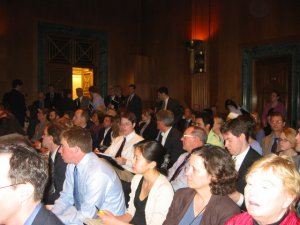Michael Riordan invited us to publish the following Opinion Piece, which was originally published in the San Francisco Chronicle on March 23, 2007. Michael is the co-author of The Solar Home Book. He teaches the history of science and technology at Stanford University and University of California, Santa Cruz. Thanks, Michael!
Time for a Carbon Tax?
By Michael Riordan
It balms my bleeding liberal heart to witness a conservative president from Texas and a Republican governor of California promoting renewable energy. Also known as alternative energy, it was widely advocated by environmentalists after the 1970s energy crisis and heartily embraced by President Jimmy Carter and Gov. Jerry Brown. But President Bush’s oil-patch friends ridiculed renewable energy as impractical, and it faded from the national agenda during the Reagan years — to be resurrected only recently. Perhaps the time has finally come to revive yet another radical idea: a carbon tax, which charges anyone who burns fossil fuels for the problems that ensue.
Of course, the word "tax" sends shudders across the political spectrum, but it shouldn’t, especially when the only good alternative is another hot-button word, "subsidy."
During the late 1970s, tax credits and other subsidies encouraged ill-considered technologies, such as solar-heating panels on roofs, that didn’t make much economic sense. Some renewable-energy advocates argued that governments should not subsidize any sources of energy — whether fossil fuel, solar, wind, biofuels or nuclear. Just get out of the economic way and let market forces determine the outcome — and penalize detrimental energy sources by taxing them accordingly.
Today, a different dynamic is operating. Global warming, then regarded as a distant possibility, is widely accepted in scientific — and, increasingly, business — circles as a looming threat that we must confront. In the wake of Hurricane Katrina, a majority of the U.S. population regards global warming as fact, caused by human introduction of carbon dioxide into the atmosphere. All of us are contributing by burning fossil fuels, and we are just beginning to witness the terrible consequences.
Thus, a rational course of action is to penalize those who burn fossil fuels — all of us — and use the revenues to implement solutions. This tactic would discourage actions detrimental to the environment and encourage energy alternatives, which could range from energy-efficiency measures to carbon-removal methods to renewable-energy sources.
A carbon tax on our gasoline purchases, for example, would automatically penalize owners of gas-guzzlers while promoting hybrid and flex-fuel automobiles. The average miles-per-gallon of U.S. cars would steadily rise in response to such a measure, as individuals take this added cost into account when making purchases.
The real key to widespread acceptance of a carbon tax, is to put the money directly to use on solving our energy problems — not just pour it into the general fund, where it can be diverted. Carbon taxes could pay for loans or even grants for insulation and double-glazing of windows in older homes, especially in cases where owners cannot afford to make such improvements. They can fund much-needed research and development on ways to capture and remove carbon dioxide or subsidize power companies that begin to take such measures with their emissions. They can support tax credits to homeowners who install solar cells, as California is doing through its Million Solar Roofs program. They can fund much-needed research on converting agricultural waste, wood chips and switchgrass to biofuels, or to solve the knotty problems of fuel-cell automobile engines and compact hydrogen-storage systems.
As Americans consume about 9 million barrels of oil daily for transportation, a dime-per-gallon gas tax thus would yield nearly $14 billion annually for such purposes. This amount does not include taxing coal, oil and natural gas burned in electrical power plants or for heating our homes and office buildings, which would probably add twice that amount.
A small carbon tax applied across the board, wherever fossil fuels are burned, thus would yield more than $50 billion a year to help address global warming. We already do something like this with the gasoline taxes that go directly into highway construction and repair. It is not all that new of an idea.
Spending these funds wisely, of course, will require some kind of responsible governmental decision-making body. Given the politics and corruption that often swirl around large pools of money, this will not be easy. But with openness, vigilance and leadership, it can succeed.
Meanwhile, renewable energy sources would begin to flourish. It would finally become economical to tap the vast supplies of renewable energy that course through our communities daily. Just imagine solar-cell panels on millions of homes converting the sunlight shining on them into thousands of megawatts of electricity fed back into the power grid. And the local construction jobs thus created will be awfully difficult to export to China or India.
Achieving this worthwhile goal cannot happen without courageous political leadership, for few can stomach a new tax. That is why so many politicians, including Sen. Dianne Feinstein, D-Calif., favor a "cap-and-trade" emissions-trading scheme, whereby companies are allowed to emit limited amounts of carbon dioxide, but can trade these allowances like stocks and bonds.
Fortunately, we are beginning to get the needed leadership in California, thanks to an inspired governor working across the aisle with Democrats on energy issues. What better legacy could President Bush leave when he departs from office in two years?

 Gore also suggested that the United States push for the next global warming treaty to begin in 2010, two years before the expiration of the Kyoto Protocol.
Gore also suggested that the United States push for the next global warming treaty to begin in 2010, two years before the expiration of the Kyoto Protocol. The briefing was sponsored by the Environmental and Energy Study Institute. Attendance at EESI briefings generally runs between 75 to 100, and the packed house for the March 14 panel was taken as a sign of surging interest in carbon pricing.
The briefing was sponsored by the Environmental and Energy Study Institute. Attendance at EESI briefings generally runs between 75 to 100, and the packed house for the March 14 panel was taken as a sign of surging interest in carbon pricing. The bottom line: peak oil will come some day, but not soon enough to avert climate catastrophe. I’ve long maintained that "peak oil" wouldn’t be a climate lifesaver. In my first talk centered on carbon taxing, at the "Philly Beyond Oil" meeting in 2005, I noted that $70 crude would "stimulate conservation, extraction and substitution," and that only the first of this trio (conservation) would be a climate-helper. Quoting the trenchant economics writer
The bottom line: peak oil will come some day, but not soon enough to avert climate catastrophe. I’ve long maintained that "peak oil" wouldn’t be a climate lifesaver. In my first talk centered on carbon taxing, at the "Philly Beyond Oil" meeting in 2005, I noted that $70 crude would "stimulate conservation, extraction and substitution," and that only the first of this trio (conservation) would be a climate-helper. Quoting the trenchant economics writer